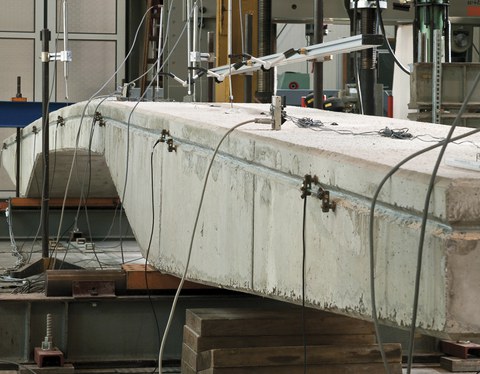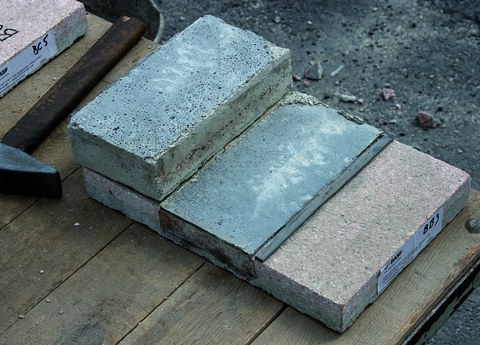Thin concrete layers on long bridges
Table of contents
Project data
| Titel | Title Dünne Betondecken auf Brücken mit Übergangskonstruktionen | Thin concrete layers on long bridges Förderer | Funding Bundesanstalt für Straßenbau BASt Zeitraum | Period 01.2007 – 12.2010 Leiter | Project Manager Prof. Dr.-Ing. Dr.-Ing. E.h. Manfred Curbach Bearbeiter | Contributor Dr.-Ing. Harald Michler |
Report in the yearbook 2010
Thin concrete ceilings on long bridges

Beam with polyurethane membrane, loading at cantilever end
An 8 cm thin concrete-based overlay for road bridges has been being designed, analyzed and tested for use as top layer of bridge coatings according to the German governmental regulations, ZTV-ING. This concrete surface layer is attached to a polyurethane membrane. The concrete slab is to ensure a high stability to traffic. The liquid plastic sealing layer will give the reliable sealing of the underlying bridge structure. This new system is designed to be used to replace existing asphalt bridge coatings and to construct new bridges with a minimum of additional mass added to the dead load of the bridge structure. It should be a cost efficient solution and can improve bridge overlay sustainability needed to handle ever-growing traffic loads while simultaneously minimizing any increase to the bridge’s dead load.
Large-scale experiment. First tests are done, conducted on laboratory scale specimens to investigate relevant parameters:
- temperature effects (-40 °C to +50 °C);
- loading rate (0.25 mm/sec to 0.003 mm/sec);
- relaxation;
- load-cycles (up to 100);
- shear load capacity and
- diathermancy.
With that it was possible to do extensive FEM simulations to evaluate the behaviour of the construction in a second step.
At the third step there are done large-scale tests. These tests are based on the former research and will expand it. The main task is to verify the FEM simulation in a practical experience. A 13.5 m long beam, shaped like a cross section of a bridge deck, was made. This construction was tested by bending. A high amount of bending deformation was needed – much more deformation considered to practice – to stress the construction to a significant step. The focus lay primarily on the properties of the polyurethane membrane which depend on the loading time and rate, e. g., relaxation.
Results. With the large-scale experiment carried out it was shown, that the construction is able to carry all loads occurring in practice. In addition, it was possible to predict the strain of the construction with the FEM simulation. Now, when using the model, it is possible to predict the behaviour of different material combinations on the basis of small scaled experiments. Suitable material compounds can therefore be specified for special requirements and the construction interpreted correspondingly in a simple way.
These data won at the reference system (small scaled tests) and in the large-scale experiment shows the ability (qualification) and the scope of this bridge-deck design. This newly developed thin concrete overlay system has the potential for practical applications in the reconstruction and new construction of road bridge structures.
Report in the yearbook 2009
Thin bridge concrete overlays

Broken specimen; right: surface sand blasted, middle: crushed interface to thin concrete deck, left: deck, bottom up
An 8 cm thin concrete-based overlay for road bridges is currently being designed, analyzed, and tested for use in the top layer of bridge coatings. This overlay, which is attached to a polyurethane membrane, provides the level of waterproofing required in bridge construction under the German governmental regulations, ZTV-ING, while insuring a means of material insulation from the elements. The main objective of this study is to improve bridge overlay sustainability needed to handle ever-growing traffic loads while simultaneously minimizing any increase to the bridge’s dead load.
A new cement-based overlay system was designed as the first step in this process. Given the positive results from preliminary analyses, it is possible to use this new system to replace existing asphalt bridge coatings and to construct new bridges without adding additional mass to the dead load of the bridge structure.
Exploration of material parameters. It was necessary to determine the material parameters of the polyurethane membrane in combination with this new 8 cm concrete overlay in spite of the successful use of these membranes in current bridge construction. Tests were conducted on laboratory scale specimens compared to standard bridge deck overlay systems, normal stresses at the membrane interface were significantly lower in the newly developed system. Relevant parameters investigated include:
- Temperature effects (-40 °C to +50 °C);
- Load speed (0.25 mm/sec to 0.003 mm/sec);
- Relaxation;
- Load-cycles (up to 100);
- Shear load capacity; and
- Thermal conductivity.
Results from these tests, including any changes to and interrelationships between parameters, were used as the basis for an FEM simulation used to determine load impacts, such as temperature change in temperature and temperature progression over time (i. e., one or more days). Full-scale testing of a 14 m slab specimen is planned for Spring/Summer 2010.
The data and corresponding reference system demonstrate the ability to use this thin concrete overlay system to provide improved bridge overlay sustainability without adding to the bridge structure’s dead load. Together, experimentally determined stress measurements, computer simulations, and knowledge obtained from full-scale testing can be used to develop the most efficient design for this 8 cm thin concrete deck overlay.
This newly developed thin concrete overlay system has the potential for practical applications in the reconstruction and new construction of road bridge structures.
